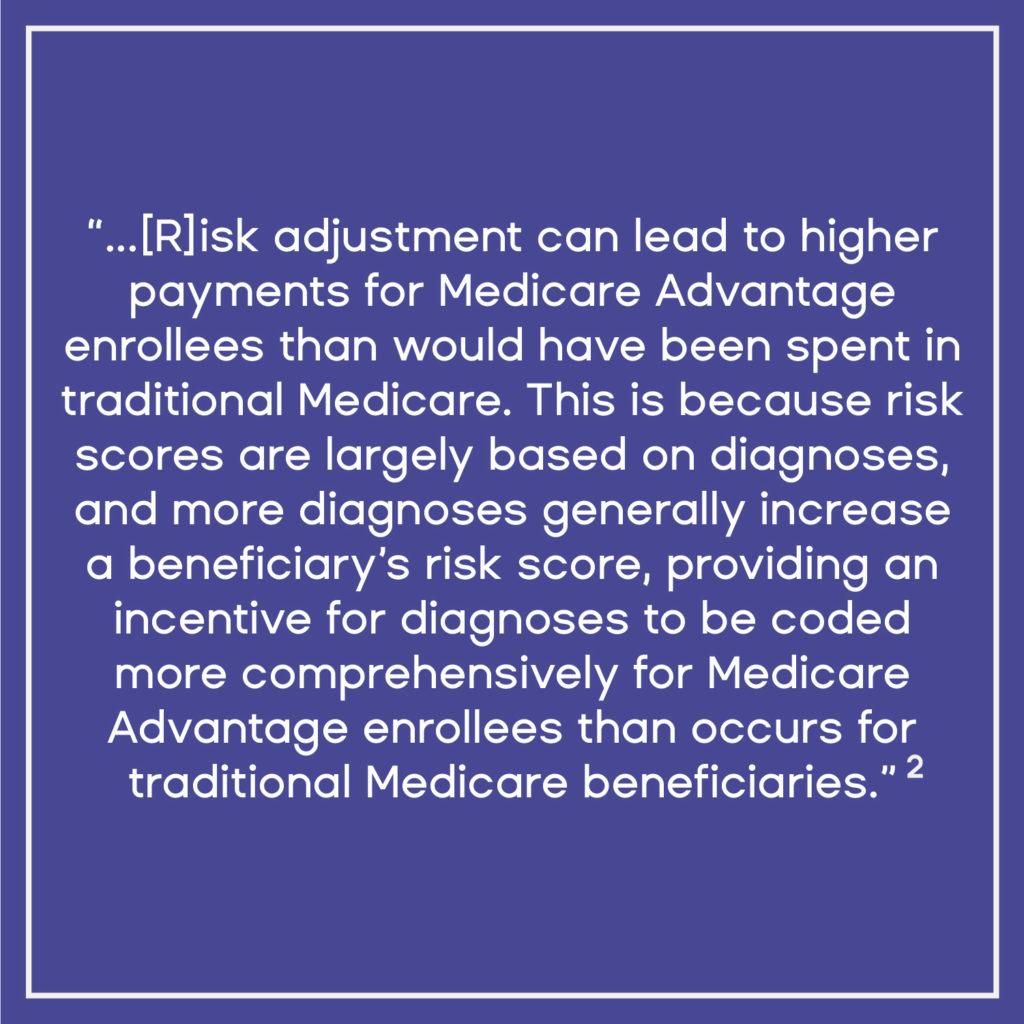For years, Medicare Advantage plans have provided an alternative path for Medicare beneficiaries to access their benefits. Instead of accessing their Medicare benefits directly through the federal government, beneficiaries can choose to join a privately managed Medicare plan. Termed Medicare Advantage plans, these health plans are run by private HMOs or PPOs and administer the government-mandated benefits (as well as additional benefits, depending on individual plan design), with the theory being that incentivized private actors could create efficiencies to lower the cost of providing adequate care to the Medicare population. But based on subsequent reviews, these plans have not only undermined value-based medical care but significantly increased costs. In fact, Medicare Advantage plans resulted in an additional annual cost of $321 per person when compared to Traditional Medicare in 2019.
One reason that the Centers for Medicare/Medicaid Services (CMS) is pursuing a direct contracting model is because of these failures. The vision for Medicare Advantage plans was to allow private HMOs and PPOs to use Medicare dollars to improve care quality. By paying these private companies using a capitation model, CMS hoped they would pursue a value-based medical care approach. Unfortunately, because of the way payments were structured, this didn’t occur. By understanding how Medicare Advantage plans failed, one can appreciate how a direct contracting model offers a better approach.
The Basic Structure of Medicare Advantage Plans
CMS hypothesized that Medicare programs could be better managed through the private sector. As a result, CMS offered to pay private HMOs and PPOs a set rate per Medicare beneficiary. In other words, CMS created a set premium compensation plan for Medicare Advantage plans, based on the actual patients that joined a given plan. Because these private insurers would receive a set amount, CMS assumed they would do their best to cut costs. This would presumably maximize their profits and result in more value-oriented care. The end result would be positive for both CMS and private insurers if all went well.
To date, however, this vision has not been realized. In aggregate, Medicare Advantage plans spent an additional $7 billion on the cost of providing care to their beneficiaries over what traditional Medicare would have spent in 2019 for providing care to the same population. For the coming decade, some have speculated that continuing Medicare Advantage options would accumulate $183 billion in extra costs. This has been a major incentive for change, which is why CMS has now introduced the Direct Contracting model. Unlike Medicare Advantage, Direct Contracting empowers providers to take on the risk of providing high quality, efficient care to Medicare beneficiaries, obviating the need for a health plan to sit in the middle of Medicare, providers and patients. As providers will have direct exposure to the risk of lowering costs (and CMS has learned some lessons in the course of administering Medicare Advantage), they are more likely to actually reduce overall Medicare spending.
Benchmarks, Rebates, and Bonuses
In part, Medicare Advantage plans have failed to achieve their objectives because of the core mechanics of the model’s reimbursement structures. CMS offers Medicare Advantage plans opportunities to receive rebates and bonuses: if a Medicare Advantage plan receives high-quality ratings, they are able to collect bonus payments. The higher the quality rating, the higher the reimbursement. This structure was designed to encourage value-based medical care through higher-quality services. But at the same time, it also resulted in higher payments in excess of what Medicare normally allowed.
However, the highest impact to the efficiency of Medicare Advantage plans is the role of risk coding and the risk adjustment factor (RAF). The amount Medicare will pay a plan in premiums for managing the care of a given Medicare beneficiary depends on the regional cost of providing services and the disease burden of that patient (in other words, how sick they are). CMS calculates a single number that represents the ‘sickness’ of a given beneficiary by summing up the various conditions a provider has certified that patient has in the course of providing care – and the amount the health plan receives is proportional to this score. Unsurprisingly, private plans have found ways to inflate these scores as a way to receive greater reimbursements for providing the same level of care to a beneficiary. This has largely ended up in offsetting any efficiencies gained through private administration of Medicare benefits.
Moving Away from Fee-For-Service
The Direct Contracting model is focused on diminishing the role of fee-for-service reimbursements. By placing greater emphasis on capitation and care quality, the Direct Contracting model reimburses for the outcomes of services, not the actual delivery of those services. To an extent, CMS does have a similar structure with Medicare Advantage plans, but as the health plan is in the middle of Medicare and providers, and as those providers are still almost universally reimbursed in a fee-for-service construct, the overall outcome is vastly different: the model still encourages providers to perform more healthcare services because this results in greater payments.
The goal of Medicare Advantage was to shift Medicare towards more value-based best practices and thereby create efficiencies in the delivery of Medicare benefits. However, adopting a capitation model for Medicare Advantage insurers alone was not enough to accomplish this. Because provider compensation for Medicare services didn’t change, provider-generated efficiencies were limited and offset by inflated RAF scores. Likewise, the continued fee-for-service structure for providers failed to incentivize them to be more selective in the services rendered. This has been a major pitfall of Medicare Advantage plans that CMS evidently hopes to correct with its Direct Contracting model.
A New and Improved Approach to Value-Based Medical Care
In some respects, CMS’ Direct Contracting model adopts features of Medicare Advantage plans. Both take advantage of a capitation-based approach to reimbursements–one to the health plan, via insurance premiums, and one directly to providers in the form of capitation of set services. Likewise, both models assign quality-focused benchmarks that incentivize value-based medical care. And, through the Direct Contracting Entity’s ability to create a network of preferred providers, both leverage the notion of an aligned network to better facilitate care delivery. But the differences are more salient than the similarities. The Direct Contracting model moves providers away from a fee-for-service reimbursement mechanism, it drastically minimizes the inflationary impact of risk coding, and it directly incentivizes provider performance without the intermediation of a health plan.
The new structures and incentives necessitated by the Direct Contracting model are likely to push greater investment by participating providers toward embracing the best practices of value-based medical care. The more fulsome alignment of providers and Direct Contracting Entities will also provide greater opportunities for collaboration. Through creativity and insights, all stakeholders can design innovative strategies to better realize value-based medical care. And in the process, these new approaches will hopefully present opportunities for meaningful savings for the Medicare trust fund.
1 Higher and Faster Growing Spending Per Medicare Advantage Enrollee Adds to Medicare’s Solvency and Affordability Challenges https://www.kff.org/medicare/issue-brief/higher-and-faster-growing-spending-per-medicare-advantage-enrollee-adds-to-medicares-solvency-and-affordability-challenges/







